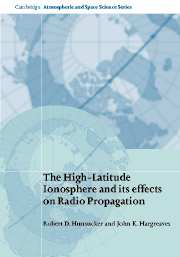Book contents
- Frontmatter
- Contents
- From the Times of London
- Preface
- Chapter 1 Basic principles of the ionosphere
- Chapter 2 Geophysical phenomena influencing the high-latitude ionosphere
- Chapter 3 Fundamentals of terrestrial radio propagation
- Chapter 4 Radio techniques for probing the ionosphere
- Chapter 5 The high-latitude F region and the trough
- Chapter 6 The aurora, the substorm, and the E region
- Chapter 7 The high-latitude D region
- Chapter 8 High-latitude radio propagation: part 1 – fundamentals and early results
- Chapter 9 High-latitude radio propagation: part 2 – modeling, prediction, and mitigation of problem
- Appendix: some books for general reading
- Index
Chapter 5 - The high-latitude F region and the trough
Published online by Cambridge University Press: 02 December 2009
- Frontmatter
- Contents
- From the Times of London
- Preface
- Chapter 1 Basic principles of the ionosphere
- Chapter 2 Geophysical phenomena influencing the high-latitude ionosphere
- Chapter 3 Fundamentals of terrestrial radio propagation
- Chapter 4 Radio techniques for probing the ionosphere
- Chapter 5 The high-latitude F region and the trough
- Chapter 6 The aurora, the substorm, and the E region
- Chapter 7 The high-latitude D region
- Chapter 8 High-latitude radio propagation: part 1 – fundamentals and early results
- Chapter 9 High-latitude radio propagation: part 2 – modeling, prediction, and mitigation of problem
- Appendix: some books for general reading
- Index
Summary
Circulation of the high-latitude F region
Introduction
The high-latitude ionosphere is greatly influenced by the outer magnetosphere and the solar wind, the essential connection being via the geomagnetic field. Through this connection the high-latitude F region is exposed to the interplanetary medium and thence to disturbances originating in the Sun. The circulation of the magnetosphere (Section 2.4.1) establishes a corresponding circulation pattern in the high-latitude F region. Although production by solar EUV is still important, these added features lead to a more complex ionosphere, which exhibits some striking differences both from the middle- and from the low-latitude zones. In describing the F region at high latitude, therefore, we shall be particularly concerned with two underlying factors:
(a) the dynamic nature of the high-latitude ionosphere, the pattern of circulation of the F region being mainly controlled by the solar wind and its variations, and
(b) the influence of energetic particles from the magnetosphere and the solar wind, to which the region is generally more accessible than is the ionosphere at lower latitudes.
The auroral zones, which occur within the high-latitude region, are particularly complex, and the trough of depleted ionization on its equatorward side has its own pattern of behavior. The present chapter deals with the behavior of the highlatitude F region, its patterns of circulation, and their consequences. The auroral phenomena are discussed in Chapter 6.
Information
- Type
- Chapter
- Information
- Publisher: Cambridge University PressPrint publication year: 2002
Accessibility standard: Unknown
Why this information is here
This section outlines the accessibility features of this content - including support for screen readers, full keyboard navigation and high-contrast display options. This may not be relevant for you.Accessibility Information
- 1
- Cited by
